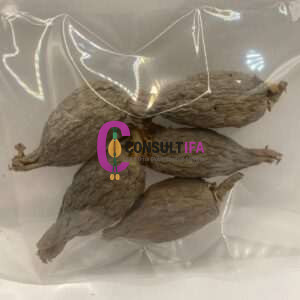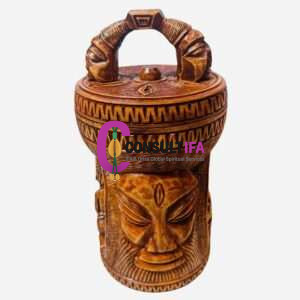Oshún, a revered Yoruba deity and Orishá, serves as a pivotal figure in African and Afro-diasporic religions, closely related to Olodumare and Shango. This powerful orisha embodies elements such as water, seduction, and love. Her image resonates with people around the world, shedding light on humanity’s diverse traditions and cultures.
Oshún’s representation extends beyond her sacred home in Nigeria to festivals worldwide where she is honored with offerings of honey, her favorite food. Understanding Oshún’s story helps us respect the rich tapestry of life that she symbolizes – from power to humility, from the sweetness of honey to the flow of water. In essence, she is more than just an orisha; she is a beacon guiding us towards understanding our place in this vast world.
Understanding Oshun: The Yoruba Goddess of Love and Fertility
Oshun, the Yoruba goddess of love and fertility, has a profound influence not only in Nigeria, where Yoruba culture originated, but also in various other countries and religions around the world. In the Americas, particularly in Brazil and Cuba, her influence is strongly felt in Afro-Brazilian religions such as Candomble and Umbanda, and in Afro-Cuban religion of Santeria.
In these religions, Oshun is venerated as a powerful deity of love, beauty, and wealth. She is also recognized in the Afro-Caribbean religion of Vodou, practiced primarily in Haiti, where she is often syncretized with the Catholic saint, Our Lady of Charity.
In the United States, the influence of Oshun can be seen in African American cultural and religious practices, especially within the African diaspora communities. The goddess is often invoked in rituals and ceremonies related to love, fertility, and prosperity.
Additionally, Oshun has found her way into neo-pagan and Wiccan practices, where she is revered for her attributes of love, beauty, and femininity. Her influence transcends geographical boundaries and cultural differences, making her a truly global goddess.
Below is a table that illustrates the various names attributed to Oshun, as recognized in different religions and countries around the world.
Name for Oshun | Religion | Country |
|---|---|---|
Ochún | Santería | Cuba |
Oxum | Candomblé | Brazil |
Osun | Yoruba | Nigeria |
Oshun | Voodoo | Haiti |
Ochun | Lukumi | United States |
Oshun’s Association with Love, Beauty, and Fertility
Oshun, also known as Osun, is a major deity in the Yoruba religion. Her domain includes love, beauty, wealth, and fertility. She’s like the ultimate love guru. If you’re seeking romance or trying to start a family, she’s your go-to goddess.
In Yoruba mythology, Oshun is depicted as a beautiful young woman adorned with yellow attire symbolizing her connection with gold and wealth. Rivers are sacred to her because they represent life-giving forces.
Importance within the Yoruba Pantheon
In the Yoruba pantheon, which is chock-full of gods and goddesses each with their unique attributes and domains, Oshun holds an important position. She’s one of the “Orisha,” divine beings that interact directly with human affairs.
She’s not just about lovey-dovey stuff though. As an Orisha of wealth too, she can bring prosperity if you’re on her good side.
Role as a Protector of Women
Oshun isn’t just celebrated for her beauty or ability to spark romance. She’s also hailed as a protector of women.
Whether it’s issues related to fertility or childbirth or simply providing strength in times of hardship. In many societies where patriarchy runs deep, having a divine female figure like Oshun offering protection provides solace and empowerment.
The Dual Nature of Oshun: Symbols and Significance
Oshun’s Associated Symbols
Oshun, the Yoruba goddess of love and fertility, is associated with several symbols. These include rivers, peacocks, mirrors, and more.
Rivers are a key symbol for Oshun. They represent her nurturing nature as well as her power to shape landscapes. Just like rivers can provide life-giving water or cause destructive floods, Oshun embodies both gentle care and fierce protection.
Peacocks also symbolize Oshun. Their colorful feathers reflect her beauty and charm. At the same time, their loud calls remind us of her assertiveness.
Mirrors are another important symbol for this deity. They represent self-reflection and truth – two aspects that Oshun values greatly.
Dual Nature Reflected in Symbols
These symbols reveal the duality within Oshun’s character. She is not just a loving mother but also a powerful protector.
Her association with rivers shows how she can be both nurturing and destructive. This reflects the dual nature of life itself – it brings joy but also challenges.
Similarly, peacocks embody her allure and assertiveness. Beauty often comes with strength, a quality that Oshun exemplifies perfectly.
Mirrors signify self-awareness and honesty which aligns with her dual nature too. She encourages us to embrace our true selves while staying honest about our flaws.
Significance Behind the Duality
The duality in Oshun’s character holds significant meaning in Yoruba culture. It reminds us that life is multifaceted – filled with ups and downs, joys and sorrows.
This duality also helps us understand our own complex nature better. We all have different sides to ourselves – some we’re proud of while others we’d rather hide away from sight.
By embracing this duality within herself, Oshun teaches us to do the same. She encourages us to accept and love ourselves just as we are – flaws and all.
Powers of Orisha Oshun
The powers of Oshún, the Yoruba Orisha of love, fertility, and rivers are as diverse as they are significant. Let’s delve into her attributes and how these shape her worship across different cultures.
Attributes of Oshún
Oshún is not just a force to be reckoned with; she’s a powerhouse in her own right. In Yoruba mythology, she is considered one of the most powerful Orishas. Her prowess extends to healing and protection, making her an essential figure for those seeking divine intervention.
For instance, she’s believed to heal the sick and bring prosperity to those in need. She also provides spiritual guidance for followers navigating life’s challenges. These attributes have earned her respect and adoration among believers worldwide.
The Healer and Protector
When you’re feeling under the weather or facing hurdles in life, Oshún steps up as a healer and protector. According to Yoruba belief system, she has the power to cure diseases and ward off evil spirits.
She doesn’t just stop at physical ailments; she also addresses emotional distress. If you’re dealing with heartbreak or depression, turning to Oshún can provide solace and comfort.
A case study conducted in Nigeria found that many people turned to Orishas like Oshún during times of severe illness or distress. They reported experiencing relief after performing rituals dedicated to these deities.
Worship Practices Across Cultures
Owing to her potent powers, Oshún is revered across various cultures worldwide. While each culture has its unique way of worshipping this deity, certain similarities exist too.
In Brazil’s Candomblé religion for example, worshippers adorn themselves in yellow outfits (a color associated with Oshún) during ceremonies dedicated to her. Similarly in Cuba’s Santería tradition, offerings like honey are made considering it’s her favorite.
Interestingly, in the United States, Oshún’s influence is seen in Afro-Caribbean communities. They host annual festivals to celebrate Oshún and her powers, showcasing their devotion through music, dance, and communal feasts.
Ceremonies, Rituals and Tools in Oshun Worship
Oshun worship is a rich tapestry of ceremonies, rituals, and tools. The followers of this goddess have unique ways of showing their devotion.
Traditional Ceremonies Honoring Oshun
The traditional ceremonies for Oshun are quite the spectacle. They’re full of color, music, dance, and joy. These ceremonies are often held near rivers – Oshun’s favorite spot. The worshippers dress in bright yellow clothes (Oshun’s color) and offer honey, pumpkins, and sweet things to her. Music is a big part of these events with drums beating rhythmically throughout.
One major ceremony is the “Oshun festival“. It’s held annually in Nigeria where thousands gather by the river to honor her.
Rituals for Seeking Blessings
People perform certain rituals to seek blessings from Oshun. They might be seeking love, wealth or health – all realms that Oshun governs.
For example, if someone is searching for love they would prepare an offering plate with honey (because she loves sweetness), cinnamon (for attraction), and five copper coins (representing her number). This ritual involves speaking your wishes aloud while making the offering at a riverbank.
Tools Used in Ceremonies
Certain tools hold symbolic value in these ceremonies. The mirror represents beauty and self-awareness; it’s used as a reminder that we should love ourselves first before seeking love from others. Copper items symbolize wealth as copper was once considered valuable currency.
A sistrum (a type of rattle) is another tool used during worship; its sound calls upon Oshun’s presence during ceremonies.
Oshun in Brazil and Candomblé: Cross-cultural Influence
Adaptation of Oshun Worship in Brazilian Candomblé
Brazil’s Candomblé religion, deeply rooted in African Yoruba tradition, has adopted the worship practices for Oshún, the river goddess. This adoption is not a mere copy-paste job but a unique blend of cultural nuances that reflect the Brazilian spirit.
For instance, offerings to Oshún include honey and pumpkins, items common in both Yoruba and Brazilian cultures. These shared elements bridge the gap between two distinct traditions, creating a rich tapestry of interconnected beliefs.
Cross-Cultural Influences Between Yoruba and Brazilian Practices
The influence between Yoruba tradition and Brazilian religious practices goes beyond shared offerings. It extends to rituals, ceremonies, and even music.
Yoruba songs praising Oshún have been incorporated into Candomblé ceremonies with Portuguese lyrics. This fusion of language mirrors the blending of cultures that characterizes Orisha worship in Brazil.
Moreover, Yoruba divination methods are used alongside Afro-Brazilian ones during consultations with Orishas. The result is a spiritual practice infused with diverse cultural influences.
Shaping Modern Perceptions of Orishas Like Oshún
This cross-cultural exchange has significantly shaped modern perceptions of Orishas like Oshún. Today’s representation of these deities often reflects their dual African and South American heritage.
In popular culture, artist Thalia Took portrays Oshún as an Afro-Brazilian woman adorned with sunflowers (her favorite flower according to both traditions). This image embodies the unity achieved through cross-cultural dialogue within religious practices.
Furthermore, this cultural exchange extends beyond visual arts into literature and film where stories about Orishas often highlight their multi-faceted identities formed by different cultural influences.
The Legend of Osogbo Sacred Grove and Oshun
The Tale Behind the Grove
The story of the Osogbo sacred grove and Oshun is deeply rooted in Yoruba tradition. This enchanting tale begins with the Yoruba people, who were guided by their deity Shango to settle near a river.
They soon found out that this wasn’t just any river. It was the dwelling place of Oshun, a powerful orisha known for her love, beauty, and healing powers. The people built a grove around the river to honor and worship her.
But life wasn’t all rosy. There was a time when their town was plagued by drought. Crops failed, and water sources dried up. Desperate, they turned to Oshun for help.
The beautiful orisha made them an offer: she would provide water if they promised to celebrate her annually with a festival. Left with no choice, they agreed.
As promised, Oshun filled their river once again with water. True to their word, the Yoruba people have celebrated the Oshun festival every year since then at the sacred grove in Osogbo city, Nigeria.
Significance in Yoruba Tradition
In Yoruba tradition, Oshun is more than just an orisha; she’s a symbol of survival and resilience against odds. The legend has it that when Olodumare (the Supreme Being) sent other deities (orishas) to create earth but forgot to send along water, it was Oshun who saved the day by creating rivers across earth.
This legend underscores her vital role as life-giver and nurturer in Yoruba cosmology. She’s revered as one who brings prosperity and fertility – hence why many women pray to her for children.
Modern Worship Practices
Even today, thousands flock to Osogbo annually to participate in the Oshun festival. This two-week-long celebration is a spectacle of dance, music, colorful costumes, and offerings to appease and honor Oshun.
The highlight of the event is when a virgin carries a calabash filled with gifts from the town’s people to the river – symbolizing their collective offering to Oshun. It’s believed that if she accepts their gifts, she’ll bless them with health, prosperity, and fertility for another year.
Conclusion
This article has delved into the multifaceted nature of Oshun, the Yoruba goddess of love and fertility, highlighting her symbols, significance, and powers. The exploration of ceremonies, rituals, and tools used in her worship further illustrates the depth of this ancient religious tradition.
The influence of Oshun transcends geographical boundaries as seen in Brazil’s Candomblé religion. The practice of honoring Oshun through prayers, altar creation, and offerings is a testament to her enduring relevance in contemporary societies. The importance of rituals for blessings such as spells, sacred baths, and fertility offerings underscores the practical applications of this spiritual belief system.
The legend of Osogbo Sacred Grove exemplifies the intertwining of mythology and reality in the veneration of Oshun. This narrative serves as a powerful reminder that spirituality is deeply embedded in culture and history.
FAQs
What is Oshún Orisha?
Oshún, also spelled Osun, is an orisha, or a spirit in Yoruba religion. She represents love, beauty, fertility and sensuality.





